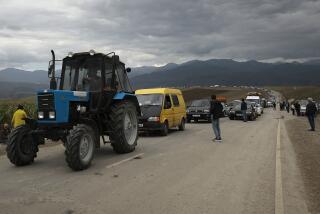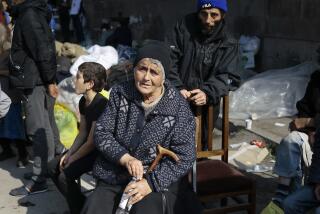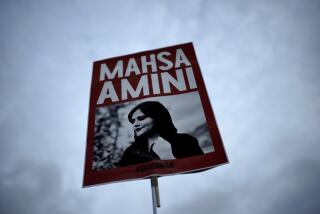2 Killed in Clashes Over Armenian Issue : Soviet Prosecutor Reveals Deaths as Protests Continue in Region
- Share via
MOSCOW — A teen-ager and a young man in Azerbaijan were killed in clashes growing out of a territorial dispute involving their Soviet republic and neighboring Armenia, a Soviet prosecutor disclosed Sunday.
Alexander Katusev also said that several people suffered bruises and other injuries when “isolated hooligan elements” in the disputed region of Nagorno-Karabakh got out of control.
Public protests continued Sunday in the mountainous region governed from Baku, the capital of Azerbaijan.
The Armenian capital of Yerevan, however, was described as “absolutely calm” at the outset of a one-month moratorium on demonstrations that drew hundreds of thousands of people to the streets over a weeklong period.
This truce was accepted after an appeal for a return to normalcy by Soviet leader Mikhail S. Gorbachev. It did not apply in Nagorno-Karabakh, located within Azerbaijan.
Beatings, rock-throwing at vehicles, setting of fires and damage to state property were reported in Azerbaijan.
Azerbaijan ‘Is Quiet’
But Katusev said in an interview with Baku Radio that was monitored by the British Broadcasting Corp.: “The state of affairs in Azerbaijan as a whole is quiet. We will be able to bring law and order in our house within the next few days.”
The prosecutor said the two deaths occurred in the Agdamsky district of Azerbaijan, which borders the disputed region, when “hooligan elements” got out of control.
“As a consequence of these disorders, two inhabitants of the Agdamsky district, 16-year-old Bakhtiar Uliyev and 23-year-old Ali Gadzhivev, fell victim to murder,” He said in a transcript of the broadcast provided by BBC. Their names indicated they were Azerbaijanis.
It was the first time that Soviet authorities have officially reported any deaths or rioting since the demonstrations began Feb. 20, seeking the transfer of Nagorno-Karabakh to Armenia.
More than three-quarters of the people who live in the Nagorno-Karabakh are Armenians, most of whom are Christians, but it has been part of predominantly Muslim Azerbaijan since 1923 despite its ethnic composition.
In another development, independent editor Sergei I. Grigoryants told reporters that not a single person was arrested during the Yerevan demonstrations because of a successful system of self-discipline.
‘Week of Freedom’
“It was an unprecedented week of freedom and democracy,” Grigoryants said after returning from a visit to Yerevan. Foreign correspondents have been forbidden to visit Armenia for the present.
The demonstrators, he said, banned drinking and kept order among themselves by following the instructions of a small organizing committee of writers and scientists.
The director of the city opera allowed its loudspeakers to be used so speakers could be heard by an enormous crowd in Yerevan’s central square, Grigoryants added.
Armenian solders who had served in Afghanistan pledged to return their war medals unless the Nagorno-Karabakh region is transferred to their republic, he said.
Demonstrators donated money to help cover organizing expenses and drivers of private cars brought food to the people jammed shoulder-to-shoulder in the square from 10 o’clock in the morning until 11 o’clock at night during the demonstrations, he said.
But there were ominous signs, too, Grigoryants added. Airport workers told him that planes loaded with troops arrived in Yerevan and were kept in reserve. Armenian police were disarmed and there were more ethnic Russian police than usual patrolling the city, he said.
‘Situation Was Dangerous’
“It was not entirely a festive atmosphere,” he said. “There was also a realization that the situation was dangerous, so that’s why the demonstrators decided to give the authorities a month to think about the issue.”
He said the protests began when the Communist Party Central Committee in January rejected a petition, signed by more than 70,000 Armenians, asking for the return of the disputed region.
Letters to Soviet leaders, he added, were never answered. When an extraordinary session of a regional assembly in Stepanakert, the administrative center of the region, was convened Feb. 20, he said, the vast majority of its members voted in favor of ceding the territory to Armenia.
The Moscow editor also brought back videotape from Yerevan, showing the main square jammed with people who shouted in unison: “Kar-a-bakh! Kar-a-bakh! Kar-a-bakh!” The film, made available exclusively to ABC-TV, was shown at the network’s offices here to correspondents. Signs in Russian carried by demonstrators said: “Self-Determination Is Not Extremism” and “Karabakh Is a Test of Perestroika, “ referring to Gorbachev’s reform program.
Parading in bright sunshine last Thursday and Friday, the serious, single-minded crowd shown in the films did not show any sign of hostility toward the Soviet state or Azerbaijan.
More to Read
Sign up for Essential California
The most important California stories and recommendations in your inbox every morning.
You may occasionally receive promotional content from the Los Angeles Times.










